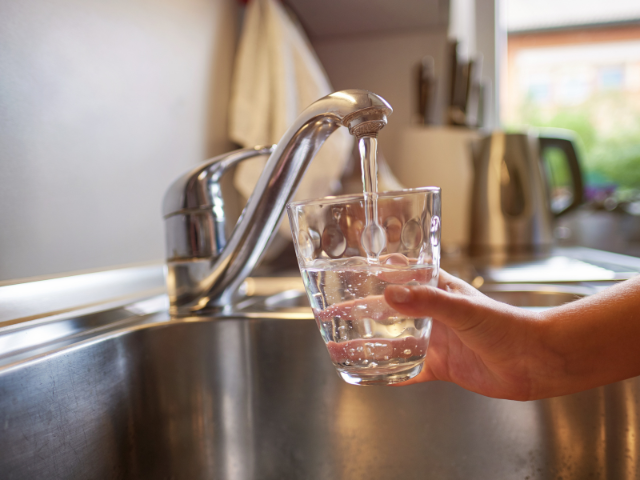Drinking Water & Wastewater
Clean water and safe wastewater treatment are essential to public health. Schenectady County is involved with various aspects of enforcing laws related to drinking water and wastewater.
Click the Icons Below to Learn More
Drinking Water Supply Systems
Safe and reliable drinking water is at the heart of our community's well-being. Whether your drinking water is distributed to your home or business from a public source or pumped from a private well, Schenectady County Public Health Services Environmental Health Division plays a critical role and enforcing the highest standards of safety and ensuring clean drinking water.
Types of Drinking Water Supply Systems
Click The Icons Below to Learn More
Community Public Water Systems
A Community Public Water System supplies water to the same population year-round. It serves at least 25 people at their primary residence or at least 15 residencies that are primary residences (ex. municipalities, mobile home parks, sub-disvisions, etc.).
Schenectady County inspects and regulates these systems regularly.
Non-Community Water Systems
There are two distinct categories of Non-Community Water Systems: transient and non-transient water systems.
- Transient non-community water systems provide water to 25 or more people for at least 60 days/pear, but not to the same people and not on a regular basis (for example, gas stations, and campgrounds).
- Non-transient non-community water systems regularly supply water to at least 25 of the same people at least 6 months per year, but not year-round (for example, schools, factories, office buildings, and hospitals that have their own water systems).
Non-Community Water Systems receive a sanitary survey regularly.
Public Water Supply Improvement
Are you looking to make improvements to your public water supply? Complete the following forms.
Schenectady County Public Health Services works collaboratively with all local municipal water departments and other public water suppliers to determine the necessity of a boil water order or advisory. In the event it is determined a Boil Water Order must be issued, Schenectady County Public Health Services issues the order to the public water supplier requiring the supplier to distribute the notice to its customers. If you have questions about a a Boil Water Order or Advisory, please contact your local public water supplier.
Why a Boil Water Order?
Boil Water Orders are issued in response to conditions that can create a potential contamination of drinking water. Common reasons for a boil water response include extended loss of pressure in the distribution system, inadequate disinfection, or other unexpected water quality problems. These disturbances can occur due to water line breaks, treatment disruptions, power outages, floods, or other severe weather.
When will the Boil Water Order be over?
Schenectady County Public Health Services will only lift a Boil Water Order if the water supplier has conducted sufficient sampling of the water system and samples have returned negative for coliform bacteria. Typically, this process takes at least 2 days. You will be notified when the order is lifted in the same fashion you were notified when it took effect.
Questions? The New York State Department of Health has resources available for residents and homeowners as well as food service establishments.
The Environmental Health Division offers County residents free analysis of coliform bacteria in private well water samples.
Why is it important to test your well?
Bacteria can enter your well water if your well is not properly maintained or sealed and protected from several sources including flooding, extreme weather, and runoff. Exposure to certain bacteria can create health risks.
How often should you test your well water?
Well water should be tested at least once a year for bacteria and every 3-5 years for other contaminants.
Water sample bottle and water analysis form must be picked up at the Environmental Health Division Office, 107 Nott Terrace, Suite 300, Schenectady, NY 12308 between 8:30am and 4:30pm Monday through Friday except for Schenectady County’s Holidays.
Water samples WILL ONLY be accepted on Thursdays. Samples should be taken on Thursday between the hours of 9:00am and 3:00pm and submitted to Suite 300 of the Schaffer Heights Building at 107 Nott Terrace prior to 3:00pm on that same day. Samples collected more than 30 hours before reaching the lab are not valid, therefore there may be times that homeowners will have to resample if the 30-hour limit is exceeded.
Procedure for taking potable water samples for bacteriological testing:
- Turn on a potable water tap (usually a kitchen or bathroom cold water tap), remove the anti-splash screen from the faucet if possible, and let cold water run for approx. 3 to 5 minutes.
- Open the sealed sample bottle, making sure not to touch the inside of the bottle or the cap.
- Do NOT rinse out bottle. (Certain bottles may contain a visible or nonvisible preservative)
- Slow down the water flow to eliminate splashing and fill the bottle to the 110 ML (milliliter) line.
- Do NOT over-fill the bottle and pour it out.
- Samples with LESS than 100ml will not be accepted.
- Securely seal the bottle, and record the name, date, and time the sample was taken on the bottle.
- Fill out highlighted areas on the “Chain of Custody Form” and return it to the Schenectady County Public Health Services, Suite 300.
- Contact the Schenectady County Public Health Services Environmental Health Division at (518) 386-2818 with any questions regarding the proper collection of the water sample.
- Capital Region Environmental Inc. will contact you with sample results. If you have questions regarding sample results, you should contact Capital Region Environmental Inc. at 518-949-2020.
- If you receive a positive sample result, please contact the Schenectady County Public Health Services Environmental Health Division at (518) 386-2818 before resampling. Our office will contact you regarding proper well disinfection procedures and/or recommendations on the proper remediation of your private well before you submit another sample.
- Use a fresh bleach solution (1/2 gallon) containing 5.25% available chlorine. Brand names: Clorox(liquid), Purex Bleach, White Sail, 101.
- Mix 1/2 gallon of bleach with 5 gallons of water.
- Pour the mixture into the well, either by removing the sanitary seal or through a vent pipe.
CAUTION - It is a good practice to disconnect the electrical power to the pump to avoid electrical shock. - Run all taps in the home or business until you can smell the chlorine odor in the water.
OPTIONAL - In some cases, it is advisable to recirculate water down the casing or the sides of dug wells for at least one hour. This can be accomplished by using a hose from an outside tap and letting the water run back down into the well. Extreme caution should be used to avoid electrical shock. - Shut off all taps and let well stand idle for at least eight (8) hours.
- After at least 8 hours (preferably 12 to 24 hours), run the water again until the chlorine odor dissipates completely. It is recommended that the chlorinated water be run via a hose to an area that avoids grass and/or shrubbery. DO NOT RUN OFF INTO SEPTIC SYSTEM.
Note: It is advisable not to bathe in, drink, cook, or wash your colored clothes while the chlorine is still at a high concentration in your water.
Engineering plan approvals and construction permits are issued by Schenectady County for the installation and repair of septic systems.
What is a septic system?
A septic system is an underground sewage treatment system. Septic systems can vary in size, depending on the amount of waste that needs to be treated. The system takes advantage of the difference in buoyancy of organic materials to separate them and allow only certain liquid materials to flow out and be further broken down by naturally occurring bacteria in the soil.
What is a percolation test?
A percolation test, also known as a perc test, is a soil test that measures the liquid absorption rate. This test needs to be performed in the area where the septic tank is planned to be installed to determine if the soil will be suitable for the treatment of the wastewater. Apply Today Below!
Online Forms and Applications
Realty Subdivisions
Proposed Realty Subdivision Checklist
View Now
Important Forms
GEN-157 Application for Approval of Sanitary Facilities for Realty Subdivisions
DOH-348 Application for Approval of Plans for Public Water Supply Improvement
Looking to pay the plan review fee for realty subdivisions?
Create a Schenectady County Citizen Engagement Portal Login. Sign in, click on Requests at the top of the page, and select Plan Review Application. Complete the form and pay by debit, credit card, or e-check if applicable.
Septic Application
Individual Application and Cover
Commercial Application and Cover
Looking to pay the plan review fee for an individual or commercial septic design plan review?
Create a Schenectady County Citizen Engagement Portal Login. Sign in, click on Request at the top of the page, and select Plan Review Application. Complete the form and pay by debit, credit card, or e-check if applicable.
Percolation Test Application
Perc Test Application and Cover
Looking to schedule a Percolation Test online?
Create a Schenectady County Citizen Engagement Portal Login. Sign in, click on Request at the top of the page, and select Percolation and Soil Boring Request Form. Complete the form and pay by debit, credit card, or e-check if applicable.








.png)
.png)

